Instructions for using HOM for processing tomatoes: nuances for open ground and greenhouses, precautions
Vegetable growers regularly face diseases affecting tomatoes. While some of them are easily treatable with folk remedies, others are more resistant and can cause the loss of the entire crop. Such dangerous diseases include late blight. The most popular remedy against it is Hom.
How often you can use "Hom" for processing tomatoes, how harmful it is, what are the nuances in the preparation and use of the solution, is it safe - you will learn all this from our article.
The content of the article
What is this drug
"Hom" is a fungicidal preparation, refers to contact pesticides of inorganic origin. It is able to resist pathogens of fungal and bacterial diseases.
In comparison with copper sulfate and Bordeaux liquid used for the same purpose, it has a number of advantages. It is used outdoors and indoors.
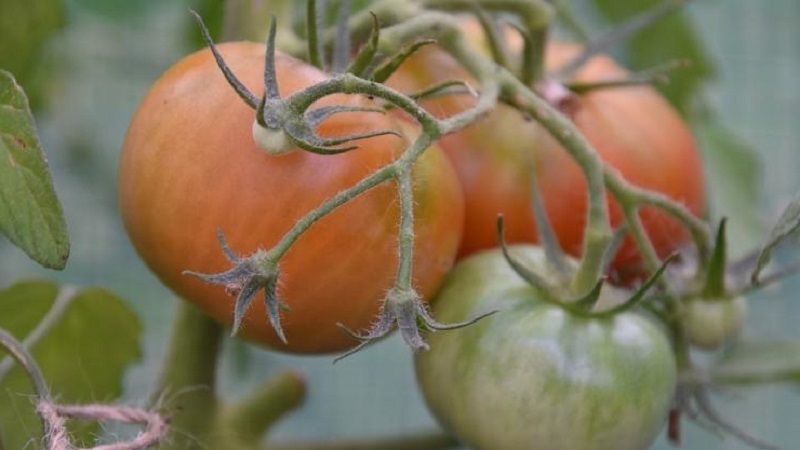
The drug is a copper chloride salt, produced in the form of a green-blue powder... It is not used in its pure form; it is diluted in water before processing. Salt crystals are not destroyed by sunlight in hot weather.
How does
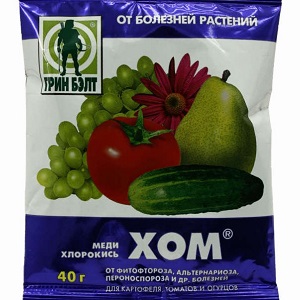 The drug is widely used not only in the agricultural industry, but also in greenhouses, greenhouses and small vegetable gardens. Hom has a wide range of uses, but most often it is used in the fight against diseases. It is also believed to accelerate plant growth and fruit ripening.
The drug is widely used not only in the agricultural industry, but also in greenhouses, greenhouses and small vegetable gardens. Hom has a wide range of uses, but most often it is used in the fight against diseases. It is also believed to accelerate plant growth and fruit ripening.
The active ingredient "Homa" is copper oxychloride... Getting into the cells of pathogens, it interferes with the process of mineralization of organic substances, which leads to their failure, as a result, the microorganism dies.
Practice has shown that after treatment with the drug rot, mildew and stains stop spreading. "Hom" acts on pathogens on the surface of stems and leaves, without penetrating inside.
You can use the drug even when the first symptoms of fungal infections appear, but the disease has not yet been determined.
Advantages and disadvantages
When deciding to treat the beds with the drug, you need to take into account his strengths and weaknesses.
Benefits:
- forms a film on plants that protects against infection;
- acts on the surface of the tomato, without penetrating into the tissues;
- destroys the cells of the pathogen;
- does not induce resistance in pathogens;
- the ability to carry out multiple treatments;
- does not accumulate in the plant;
- the drug completely disintegrates after six months;
- safe for humans if instructions are followed;
- has a low price.
Compared to other drugs for the treatment and prevention of disease Hom has a number of advantages. The drug is less toxic, does not burn the skin, is easier to prepare and can be combined with other products.
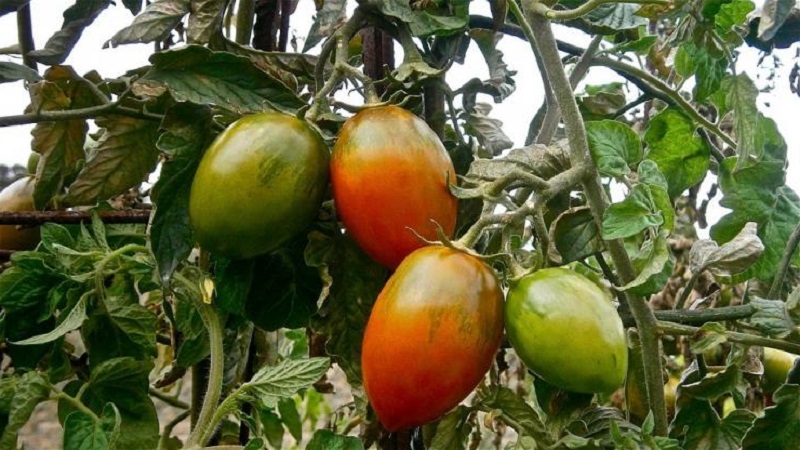
disadvantages:
- is not a drug, it helps only as a prophylaxis against diseases;
- unable to destroy the causative agent of the disease inside the tissues;
- easily washed off with water;
- uneconomical expense;
- unpleasant odor;
- has a third class of hazard, toxic.
Indications for use
"Hom" refers to fungicides... The drug is intended for the prevention and treatment in the early stages of diseases of domestic, ornamental, horticultural and garden crops.
"Hom" resists such tomato diseases:
- late blight;
- anthracnose;
- macrosporiosis;
- brown spot.
How to prepare a preparation
For standard preventive treatment, use this recipe - dilute 40 grams in 10 liters of water. drug. First you need to prepare a concentrate: dilute the powder in 70-100 ml of water. Then, stirring constantly, add water to the required volume. If Hom is used as directed, phytotoxicity can be avoided.
Important! To prepare the solution, it is better to use warm, settled water.
1 liter of solution is enough for about 10 sq.m., the consumption can be increased if it is necessary to spray tall varieties with more green mass. The solution remaining after the procedure cannot be stored, therefore, when preparing it, it is necessary to take into account the area of the garden.
Instructions for use
Hom can only be used for spraying, it is not suitable for root watering. Processing is carried out during the growing season of plants. A standard dilution method is used; for better adhesion of the product, low fat milk can be added to the solution - 0.5 cups per 10 liters of water.

The ready-made solution should be used immediately.without leaving for further processing. Spraying is carried out using a spray bottle, it is important to moisten the leaves abundantly on both sides. The procedure is best done in dry, calm weather.
You can start processing tomatoes from seedlings to the flowering period... The protection of the drug will last for 2 weeks, but if precipitation fell during this period, it is better to repeat the procedure.
Experienced vegetable growers it is recommended to start spraying with copper chloride at the end of June... During this period, the temperature at night is + 10 ° C, and heavy rains fall. These factors often lead to the development of fungal diseases.
Read also:
Fighting tomato cladosporium disease in a greenhouse easily and effectively
Soil treatment
If last season the plants were sick with late blight, you can disinfect the soil before planting with the "Homa". For this, the drug is introduced into the wells. It is worth considering that the active substance will destroy not only pathogens, but also beneficial microorganisms.
You can reduce the harm of the drug, using such a solution - 4 gr. copper oxychloride per 1 liter of water. The tool is used a few days before planting seedlings. You can pour the solution over the beds using a watering can or pour 200 ml into the planting hole. Plants can be planted 2 days after treatment.
Precautions
When working with the drug, follow the ruleswhich will make the treatment effective for tomatoes and safe for humans.
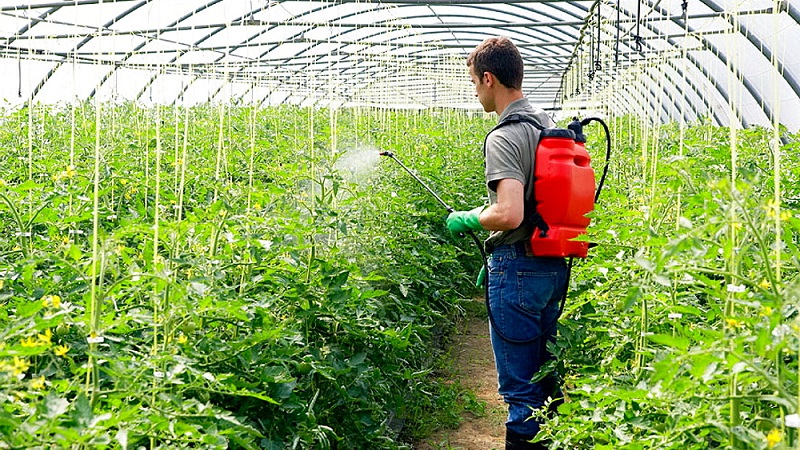
Basic rules for using "Homa":
- Cook every time new solution.
- Do not exceed proportions and comply with the processing standards.
- Use the drug with an unexpired shelf life.
- Processing is carried out in the morning or in the evening at a temperature not exceeding +30 ° С.
- Spray not only the top leaves, but also their lower part.
- Use a robe, respirator, gloves and goggles.
- During processing it is forbidden to eat, drink or smoke.
- After the procedure wash yourself thoroughly, rinse your mouth and wash your clothes.
- Store the drug separately from food, as well as alkalis.
- When preparing the solution use special dishes. It does not have to be galvanized steel or iron.
- Do not store "Hom" in rooms with temperatures below +5 ° С and above +30 ° С.
- Carry out processing in the absence of children and animals.
- Make sure that the drug did not get into water bodies.
- During flowering processing is undesirable.
- The drug can be combined with fungicides, pesticides, fertilizers and immunostimulants, except for those that have an alkaline reaction.
When and how often to process tomatoes
Hom does not promote resistance development in pathogens, therefore, each treatment with the drug will be effective. The product can be used many times, but usually 3-5 applications per season are enough.
The duration of one treatment is 10-14 days... The drug is very quickly washed off by precipitation, dew and water during irrigation, so the beds can be treated every 12 days.

Nuances of use
The drug is used both in open beds and in greenhouses.... For spraying, you need to choose calm weather, otherwise the solution will scatter over the entire area. Also, you can not carry out the procedure in direct sunlight in order to avoid burns to the leaves.
The best time to spray is morning or evening... However, many gardeners prefer the morning time, as dew can fall out at night, which will wash away the solution.
Important! If there is a hive with bees in the garden, you need to protect the insects. Before processing, you need to take out the hive, the safe distance for bees is 2 km. Insects can be returned 6 hours after spraying.
In the greenhouse
Greenhouse owners often use the drug in the fight against late blight... At the first signs of illness, treatment and treatment of the room begins. In advanced cases, the plant must be uprooted and burned.
When processing plants "Hom" you need to open the windows and doors in the room. After the procedure, the greenhouse should be ventilated for several more hours.
As a preventive measure, you can water the soil solution of the drug twice a season - after harvesting and before planting seedlings.
Can the solution harm
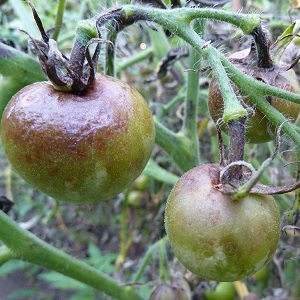 Hom is toxic to fish, and, although it is possible to treat areas near water bodies, care must be taken to ensure that unused drug does not get into the water.
Hom is toxic to fish, and, although it is possible to treat areas near water bodies, care must be taken to ensure that unused drug does not get into the water.
In the first 6 hours after treatment, it is dangerous for bees and bumblebees, during flowering it is not used. Due to the disinfection of the soil by "Hom", the number of earthworms may decrease.
The drug is also dangerous to humans., therefore, you need to take precautions when working with it.
Actions in case of poisoning with "Hom":
- At the first symptoms take the victim outside, change clothes and rinse the mouth with water.
- If the drug gets on the skin, you need to rinse the area with plenty of water or soapy water.
- If "Hom" gets in your eyes, they need to be rinsed with plenty of running water in the open state for 10-15 minutes.
- If the product is swallowed the victim should be given 250 ml of milk or 500 ml of cold water, then 0.5 g. activated carbon per 1 kg of body weight. It is forbidden to artificially induce vomiting.
- See a doctor and show him the package of the drug.
Tips & Tricks
The first goal of phytophthora in the garden is often potatoes, so experienced gardeners never plant tomatoes next to this crop... The disease can progress from diseased potatoes to tomatoes in 10 days. When processing nightshades for late blight, attention should be paid to potato beds.
You can enhance the effect of copper oxychloride by combining it with such drugs: "Fufanom", "Epin", "Inta-Vir", "Entobacterin".
Attention! Do not mix "Hom" with "Aktara" and lime, as they contain alkali.
For better adhesion of the solution to the leaves you can add a quarter bar of laundry soap instead of milk.
Reviews of vegetable growers
According to reviews, the drug copes well with various diseases. garden and horticultural crops. It is easy to use, the packaging contains instructions from the manufacturer on how to properly prepare the solution.
 Despite the availability of the tool, its popularity has declined slightly recently.... This is due to the appearance on the market of organic fungicides.
Despite the availability of the tool, its popularity has declined slightly recently.... This is due to the appearance on the market of organic fungicides.
Irina, Anapa: “I have been using Hom on my site for a long time.I process not only tomatoes with it, but also cucumbers, potatoes, onions, garden trees. It really helps to protect against disease ".
Alexey, Syktyvkar: "" Hom "is an excellent replacement for Bordeaux liquid, which requires compliance with breeding rules. Copper oxychloride is easy to use, there is no need to insist the solution, it is immediately ready for use. "
Ivan, Kazan: “The drug helps well in the fight against late blight and downy powder. But I use it in extreme cases, nevertheless it is destructive for bees ".
Popular questions
Novice gardeners may wonder if they are using copper oxychloride correctly.... We have collected the most common questions and answered them.
Can tomatoes be processed during flowering?
No, the flowering period is very important for a rich harvest.... At this time, it is better to stop processing tomatoes. In addition, flowers can attract bees and bumblebees, and the preparation is destructive for them.
If the plant is infected and you need to urgently take action, it is allowed to use "Homa" between the flowering of the first and second brush. Also, treatments can be carried out with solutions that do not have waiting times and restrictions.
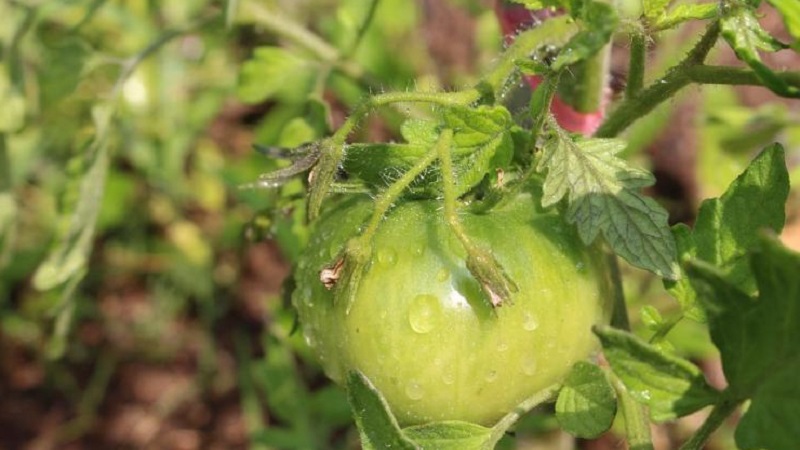
Can I spray during fruiting?
It is undesirable to do processing during this period.... The product is intended for spraying during the growing season. The last treatment is carried out 20 days before harvesting. The effect of copper oxychloride lasts up to 14 days, but the effectiveness of the solution largely depends on the concentration of the drug.
When can I eat tomatoes after spraying?
Experts assure that you can eat tomatoes 5-6 days after processing with "Hom"... The fruits can not only be used in salads, but can also be preserved for the winter.
Conclusion
Hom is one of the most widely used drugs in the garden, but its popularity is waning. Safer organic fungicides are replacing toxic substances. Copper oxychloride is still effective in preventing late blight. Treatment with this drug does not give a 100% guarantee. It acts only on the surface of the plant, and many pathogens affect the vascular system.
"Hom" does not cause resistance in pathogens, which allows multiple spraying. The drug is used during the growing season, before the flowering of the plant. You can harvest the crop 20 days after the last treatment. The product is safe for humans if you follow the recommendations for its dilution and use. Do not neglect protective measures, since the drug has been assigned a third hazard level.